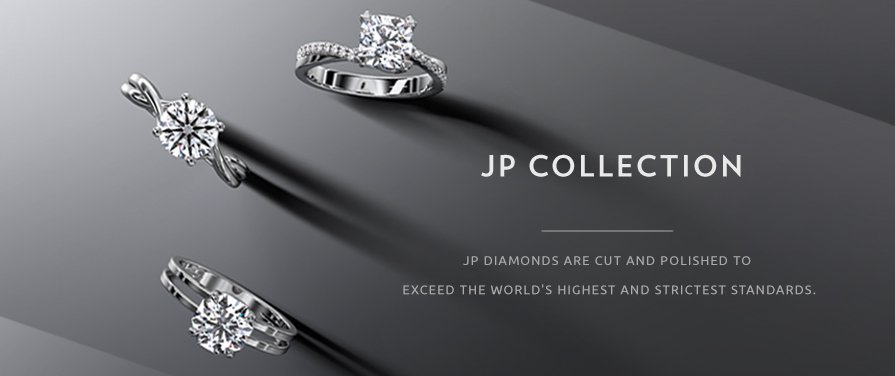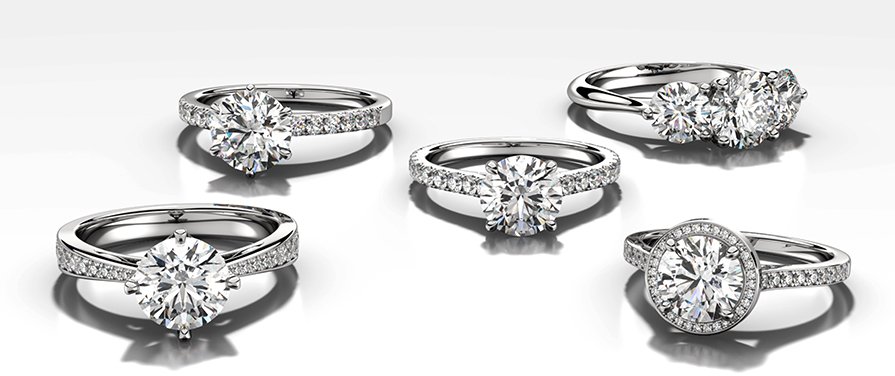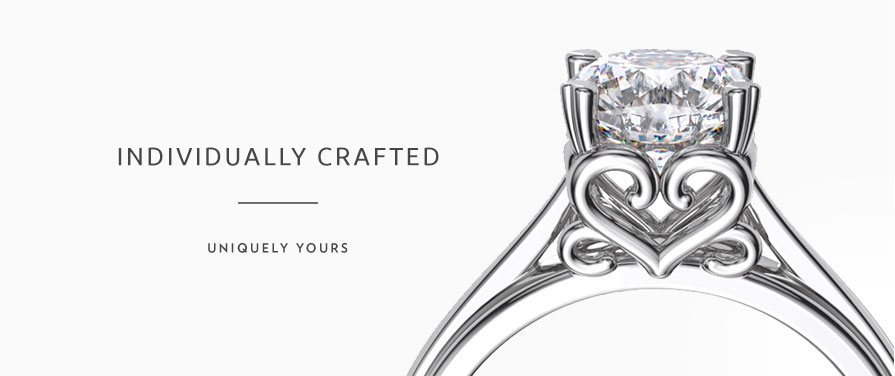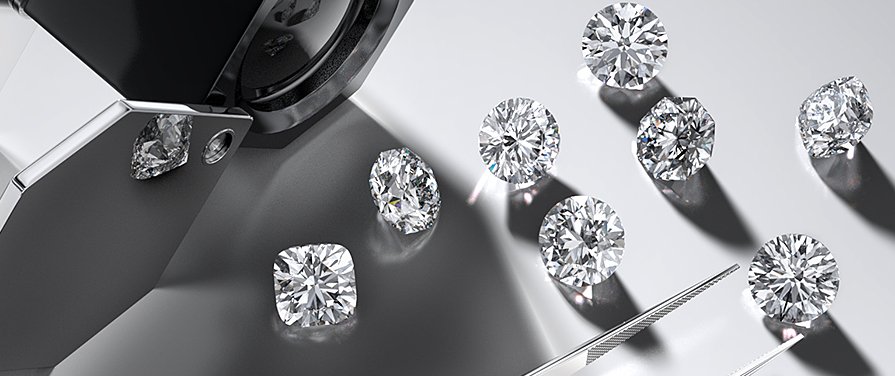The Four C'S
First off, let’s start with reading about the basics. Diamonds are weighed in carats. What is Carat? Carat is the unit of measurement of a diamond’s weight.
Metric carat equals 0.20 gram as one carat equals 0.20 gram
Carat Weight is determined in units of carats on a diamond scale. Learning Carat Weight is pretty easy when you know about the points that are involved. Points are most commonly referred to diamonds under one carat. For example:
- 0.10ct equals 10 points or a10pointer
- 0.20ct equals 20points or a 20pointer
- 0.30ct equals 30points or a 30pointer
- 0.40ct equals 40points or a 40pointer
and so on.
Only when the 3rd number is a 9, the diamonds’ weight is rounded up to the next decimal point. So for example;
- 0.995ct is rounded to 0.99ct
- 0.996ct is rounded to 0.99ct
- 0.997ct is rounded to 0.99ct
- 0.998ct is rounded to 0.99ct
- 0.999ct is rounded to 1.00ct
Now, you may hear the words “Magic Numbers” frequently when searching about diamonds. This term is described as diamond sizes that are flat. Why
Magic number weights such as 0.50ct, 0.70cr, 1.00ct, etc. are a lot more expensive than premium carat weights such as 0.89ct, 0.99ct and 1.99ct despite a
There are people in the marketplace who determine diamond prices based on its qualities, supply and demand. These reports are published in the marketplace. These pricing reports are categorized in weight. Some examples of these magic numbers in weight are;
- 0.30ct
- 0.40ct
- 0.50ct
- 0.70ct
- 0.90ct
- 1.00ct
- 1.50ct
after that last carat size, the magic number in weight increases every half carat.
Carat weight CAN affect a diamond’s value. It’s pretty simple. The larger the diamond, the more expensive it’ll be. The quality of a diamond ranges the price per carat of a diamond. Since large diamonds are rarer, the price increases as the carat weight increases.
Have a look at how different carat weights look on a finger.
The diamond’s size is NOT the same as the diamond’s carat weight. It is very possible to find two diamonds of 1.00ct and to have one that looks 25% smaller than the other. This is due to the way that the diamond is being cut. A diamond cut with a shallow depth would make the diamond appear larger in size while a diamond that is cut deeper will appear much smaller in size. In very extreme scenarios, it is possible to find a 1.00ct diamond equal to a size of a 0.40ct diamond.
A good example is
Following Carat Weight, we learn about Clarity. The
GIA’s scale of clarity grading is represented as
- No imperfections - FL or IF
(Flawless - no blemishes or internal inclusions under 10x magnification)
(Internally Flawless meaning no internal inclusions under 10x magnification)
- Minute imperfections -VVS (VVS1, VVS2)
(VVS1 - extremely difficult to see inclusions under 10x magnification)
(VVS2 - very difficult to see inclusions under 10x magnification)
- Minor imperfections - VS (VS1, VS2)
(VS1 - difficult to see inclusions under 10x magnification)
(VS2 - somewhat easy to see inclusions under 10x magnification)
- Noticeable imperfections - SI (SI1, SI2)
(SI1 - easy to see inclusions under 10x magnification)
(SI2 - very easy to see inclusions under 10x magnification)
- Obvious imperfections -I (I1, I2, I3)
(I1, I2, I3 – inclusions are obvious under 10x magnification and affects the diamond’s durability, brilliance and overall appearance.)
(Some diamond labs use the term "Pique" or pronounced as “PeeKay” using the abbreviations P1, P2, and P3, rather
than I1, I2, and I3.)
AGS’s scale of clarity grading is represented as
- AGS 0 = GIA FL and IF
- AGS 1 and 2 = GIA VVS1 and VVS2
- AGS 3 and 4 = GIA VS1 and VS2
- AGS 5 and 6 = GIA SI1 and SI2
- AGS 7,8,9,10 = GIA I1, I2, and I3
Clarity Characteristics can be Internal inclusions or external inclusions. The Size of the Inclusion, Quantity of Inclusions, Type of the Inclusion, Color/Relief(reflectivity), and the Placement of the Inclusion, determine the Clarity Grade. While diamonds with High Clarity are always in demand as they stand for purity to most, diamonds with Medium Clarity (VVS1 to VS2) can be as great as Flawless diamonds as no one can see the difference.
You should use both Darkfield Illumination and Overhead Lighting when viewing diamonds. The Darkfield Illumination is very important when determining a diamond’s clarity grade. This is a microscope that takes pictures of diamonds when it is placed under
A diamond is Eye-Clean when its inclusions cannot be seen in a ‘face up’ position and viewed 6-12 inches away from the eye. It is possible to see imperfections with the naked eye on a lower clarity grade such as SI when turned face down. Note that this view can
FL-VS2 (FL being Flawless, VS2 being somewhat easily noticeable)
From SI and
Clarity Grades
-
FL (Flawless): No internal or external inclusions. There isn’t much to say about these except they are very rare and they are priced at IF cost.
-
IF (Internally Flawless): No internal inclusions, but may have small, very unnoticeable external inclusions.
-
VVS1 (Extremely Difficult): Very very slightly imperfect diamonds. They have very small inclusions which are extremely difficult to see. They can only be seen under 10x magnification, and even then, the inclusions are hard to spot! These inclusions are so small, they can be mistaken for little specks of dust or something irrelevant to the diamond at all! If the inclusions are
a bothersome , they can be removed by a little re-polishing. -
VVS2 (Very Difficult): Experts can locate these under a 10x magnification. The inclusions are still very small, with maybe a few more minute flaws than VVS1, but it does not make VVS2 any less valuable than a VVS1 diamond.
-
VS1 (Difficult): Very small inclusions, they have more small or large inclusions than VVS diamonds. These inclusions are still
minor, and are usually not visible to the naked eye. Only skilled graders can locate them under 10x magnification. -
VS2 (Somewhat easy): Still very small inclusions but with more flaws than VS1 diamonds. This clarity grade is known as the cutoff grade for most buyers. Only a skilled grader can locate them under 10x magnification.
-
SI1 (Easy): This clarity grade is still popular because it’s an eye clean diamond, and the price difference between
a SI and a VS is huge! Buyers on a budge are more concerned about the price difference as they want a good price for a good looking diamond. The SI grade has easy to see inclusions under a 10x magnification and sometimes with the naked eye. -
SI2 (Very Easy): The inclusions in this grade get more noticeable to the naked
eye, and under 10x magnification.*SI3 Before the early
1990’s , SI3 wasnon existent . As these diamonds contain more flaws than the SI2 had, it was graded as “I” for Imperfect! The SI3 grade was made a grade for the reason that there are diamonds that have more inclusions than SI2 but not noticeable enough to be graded as Imperfect. SI3 is the grade that separates an easy to spot inclusion diamond from a diamond being considered Imperfect. However, the GIA and AGS still do not consider therebeing an SI3, they only use SI2 and I1. -
I1 to I3 (Imperfect): Diamonds with obvious inclusions in and on the stone are placed in this grade. They are both easy to see with the naked eye and jump out at you in the microscope. An eye visible
*I1 is different from I2 and I3. I3 has inclusions, but these inclusions do not affect the diamond’s overall brilliance if the diamond has a good cut grade. While this grade being classified is the lowest on the grading scale, this grade is the most common on price reports and people still buy them. If the inclusions are on the edges of the diamond, you can get prongs to cover up the blemishes on the diamond. However, severe inclusions on the edges can be a very bad thing.feather, or crystal are common. -
*I2 and I3 - These clarity grades containing large inclusions can diminish the diamond’s brilliance and affect its durability, hence why if you buy a diamond with inclusions on the edges of it, and use prongs to hide them, it can be a bad thing.
Internal Inclusions
Feather - This fissure is located within the diamond and can place a durability risk depending on how big it is and where it is located. These inclusions can be found from VVS’s to I’s.
*There are two types of feathers; straight and curvy. The straight feather( sometimes referred to ‘needle’) usually follows a cleavage plane. If the straight feather is
*Watch out for some enhanced diamonds, for they might have dangerous feathers that are hidden. Unless you know what has been done to the enhanced diamond, stay away from them. You can locate feathers by reading the clarity plot if you have a lab report. Thoroughly examine the diamond with a loupe from all angles to find feathers if your stone is not certified.
Pinpoint - Very small crystal, and it’s close to white in
Crystal - Mineral deposit found, either alone or in groups, in the inside of the diamond. It can be
Needle - An elongated inclusion. It is very similar to a feather, but it has no radiating lines. Needle inclusion is only visible to the naked eye if it has
Cloud - Known as a group of pinpoints.
Cavity - The surface of the diamond has an opening, as a result of a natural flaw in the rough stone.
Bruise - A chip in the diamond surface that may include root-like feathers radiating into the diamond
Bearding - Lines that occur during the cutting of the diamond.
Cleavage - Straight crack without any feathering
Internal Graining - Crystals that grew with a milky
Knot - Included crystal that touches the surface of a polished diamond.
Laser Lines - Slightly noticeable trails left when lasers are used to remove dark inclusions
External Inclusions (blemishes)
Scratches - Fine lines usually around the surface of a diamond, possibly caused by cutting of the diamond. Deep scratches can be removed by enhancing the diamond. These can be curved or straight.
Fracture - Usually irregular in shape, causing the diamonds to look chipped. Basically, it’s a crack on the surface of the diamond.
Nicks - Diamonds are chipped at places such as the girdle or facet edge causing nicks. Can be fixed by adding more facets, just be warned that adding too many facets, can decrease a diamond’s brilliance.
Pits - Small holes/dots white in
Polish lines - Polishing a diamond can cause minute lines during the process.
Chip - A shallow nick in the surface of the diamond created during cutting.
Natural - The original surface of the diamond which has not been polished. This is actually considered a sign of good cutting practice.
Twinning Wisp - This line is noticeable inside the diamond that may look like a ripple. Caused by an irregularity in the diamond’s structure. These are more easily seen in SI clarity grades.
That’s all for Clarity! Just always keep in mind; Do not mistake the girdle’s reflection halfway into the pavilion as an
The naked eye always detects a diamond’s light
A perfect diamond that has no hue will have a higher value. GIA grades their diamond’s
GIA Color Grading Scale
DEF - Colorless
GHIJ - Near Colorless
KLM - Faint Yellow
NOPQR - Very Light Yellow
STUVWXYZ - Light Yellow
The yellow tint in a diamond gets more obvious as you move down the
*GIA disregarded using A-C alphabets because some dealers use those grades for “
AGS has a numerical
0.0 - 1.0 : Colorless
1.5 -
3.5 -
5.0 -
7.5 - 10.0 : Light
Fancy Yellow
To get a better sense of the visual difference in
A topic that deals a lot with affecting the
A diamond’s Cut is the proportions and measurements of a diamond. The way a diamond is cut can diminish a diamond’s
There are two main factors that can hurt or improve a diamond in different aspects when it comes to a diamond’s
Fluorescence is the trace minerals in a diamond, that causes it to glow under UV (Ultra Violet) light or certain lighting conditions. Fluorescence comes from the source in where the diamond was mined. If the stone was found in an area where there was a lot of heat and left-over boron around the diamond, there will be Fluorescence within that diamond.
Fluorescence is graded:
None
Faint
Medium
Strong
Very Strong
The most common
Is Fluorescence good or bad?
Fluorescence can be bad if it affects the appearance of the diamond, causing it to look oily or milky.
This is caused mostly in daylight where the UV light rays from the sun activate the boron particles in the diamond, changing its appearance. The boron material is brought out by these factors and if the light is very strong, it can diminish the look of the diamond. Most of the time, very strong fluorescence can mask the true
For example, when you are viewing diamonds under a well-lit ultraviolet light, a lovely blue-ish white diamond captures your eye. You can’t help but to buy it, so you return home with your new possession only to notice that this beautiful blue-ish white diamond you saw in the store has now turned yellowish-white! This can happen because blue is a complementary
It may be good for a diamond to possess fluorescence if it enhances the diamond’s appearance.
Fluorescence can lower the cost of a diamond, which may be good for clients looking to buy diamonds with high clarity grades. Depending on the fluorescence, it can sometimes improve the
Basically, Fluorescence rarely affects a diamond’s sparkle and brilliance, and it can make some diamonds appear brighter and whiter in warmer
What about a diamond's tint?
Even though diamonds can be found in many
In the video below, we showed 3 piles of diamonds, where all of them are G Color, but with a brown, yellow and no tint.
There are many elements affecting the
The
Some say for yellow tinted diamonds, they would look best on platinum metals, while others say it will look just as good with a yellow gold metal or an alloy, but to each their own. This is where contrast plays a big
If you take a yellow gold metal and set your Colorless Diamond on it, the diamond will appear to contain yellow tint despite it being Colorless. If you do not want to add















